I've got a few of these interesting transitional machines bundled away - and then someone alerted me that the elecrolytic caps leak and destroy the PCBs.... so back to the drawing board I go.
Bit of background (bearing in mind a lot of history is in the wikipedia article) It's an IBM portable 386 machine from 1991 and was sold for $5995. It sits inbetween at least two flawed machines on IBM's journey to bring us portable personal computers, taking over from the Convertible - with it's hideous display, weird IBM Jnr hardware compatibility and definite bad-portability and predating the huge, black CL57 - which was similar in industrial design but edging towards Thinkpad features (being black, with the same color TFT panel as the 700c) as well as the catchily-titled N51SX, N51SCL and N45SL notebooks. It also succeeded the IBM P70/P75, which I think shares more design features with this than either of those above, but ditched the orange gas-plasma display in favour of passive monochrome LCD, lost the numeric keypad and moved the FDD to a position it would not fill up with rain and dust.
I've read page-upon-page, studied timelines and read books about IBM and the Thinkpad and I still don't really understand the journey of IBM's path to the Thinkpad. It seems the USA had all these out-dated ideas about how the design must conform to age-old colours, designs, naming conventions, testing and were pitting various different design and manufacturing outposts against each other. This brought us a bunch of fabulously varied, but all flawed machines, mostly with silly alpha-numeric names and in many cases unrelated to one another, until we get to about the 750 era where all the crappy ideas (hinges, displays, architecture) were gone.
The L40 SX is part of that journey and is actually one of the nicer ones to own. Having said that, I couldn't help but think the hinges on this thing are going to get a bit achy in another few decades....
Anyway, back to the point. I learned this machine sits right in the middle of a 'crap capacitors' epidemic - somewhere between the mid-80s to mid-2000s, where electrolytic capacitors (little cyclinders of fluid on PCBs) fail and leak. The fluid inside rots everything it touches and destroys it. You can either replace them with new ones which hopefully won't ever leak or, in some cases Tantalum capacitors which are solid-state and when they fail they just sort - annoying but not destructive. In order to start preserving mine, I decided to pull one out and tackle it blind.

It was unclear as to how many capacitors there were so I was going in blind. I've seen images of the motherboard with a certain green capacitor on the bottom-left hand side, near the left memory slot which always seems to leak and mine didn't have it or even have a lot of chips in the same spot, so definitely more than one revision - bear that in mind when looking at my notes.
This machine is fairly easy to get at and the only issue really is that the cream plastics are getting a little brittle - especially around the hinges on the LCD bezel. So take your time.
If you take the 3 screws out of the bottom/front, you can lift up the keyboard and carefully remove the two ribbon cables which are simply push-fit. This shows the front half of the motherboard. The back half is obscured by the plastic panel which has the power switch and all the LCD indicators in it, which is removed by 3 screws on the back and about 4-6 on the front, under where the top of the keyboard was. This then lifts off to show the whole motherboard.

It's also now worthwhile to completely remove the lid, which is attached by the hinges which have 2 screws either side, also removed from the rear. You need to unplug 2 cables on the left and 1 on the right and then the whole lid and hinges slide vertically off.
Now you have the mainboard accessible, you have to remove the HDD, the centre plastics around the main battery and the FDD - all of which are a few screws and ribbon cables.
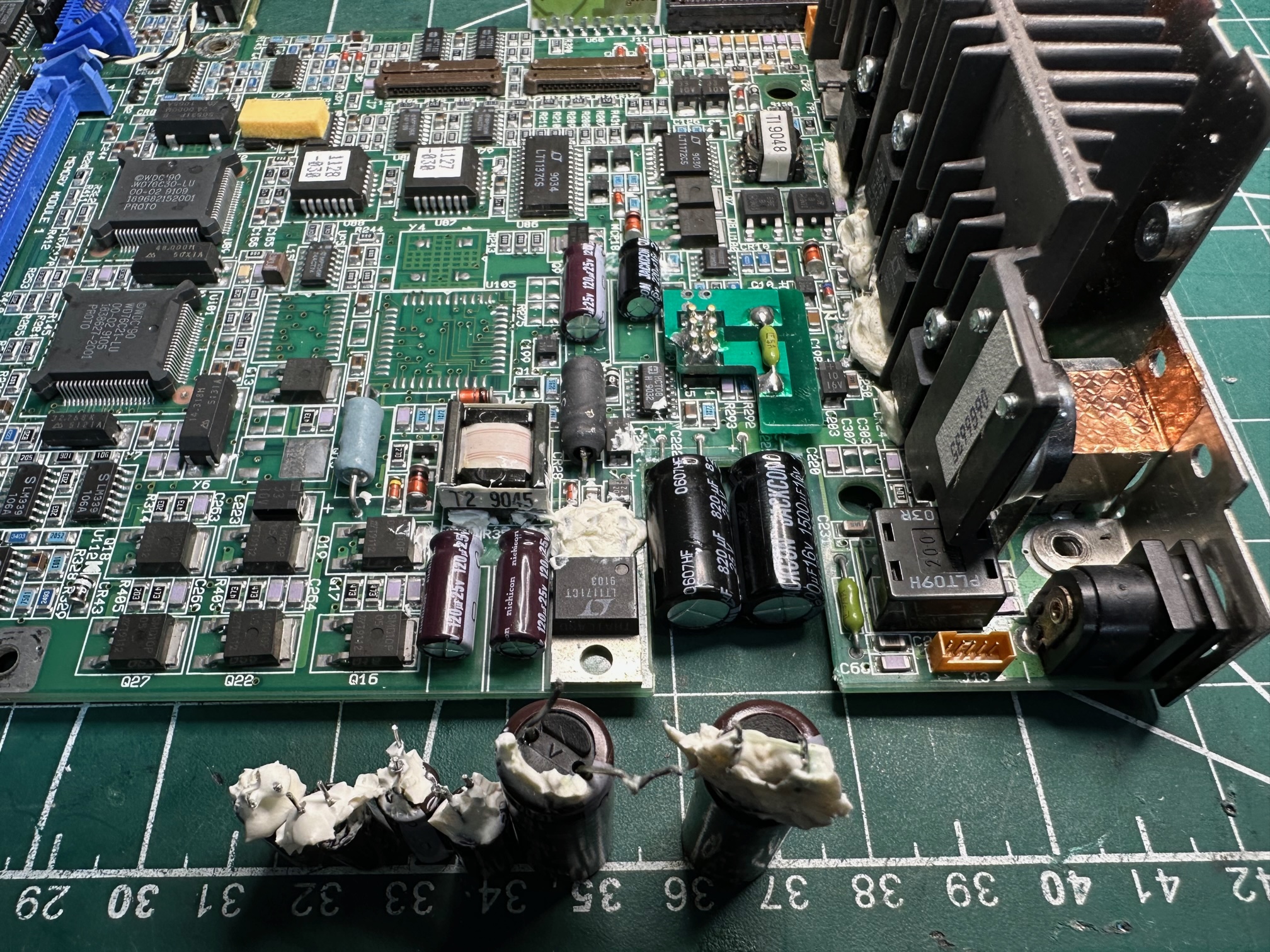
On my motherboard, there were 6 x through-hole electrolytic caps on the left which showed no signs of leakage, but I replaced them. For some reason, IBM covered the legs in which flaky white gunky glue stuff. It's dry and doesn't seem to do any damage but it does get in the way. I removed all the stuff which was around the caps and cleaned with IPA on both sides before installing the new ones.
C183 - 220uf/10v
C184 - 120uf/25v
C233 - 120uf/25v
C234 - 120uf/25v
C222 - 820uf/25v
C221 - 1500uf/10v
The mainboard has a substantial copper backpane which sucks up heat. I would strongly suggest you use a hairdryer or gun to gently warm the whole board before you start. I didn't have any trouble but then again I have a very expensive desoldering gun.
Next we move onto the LCD, which is mostly held on with friction. You remove 2 black screws from the bottom and then you have to work the LCD bezel free by gentle prying the outside of the lid away from the edges. It's nerve-bending but not too tricky.
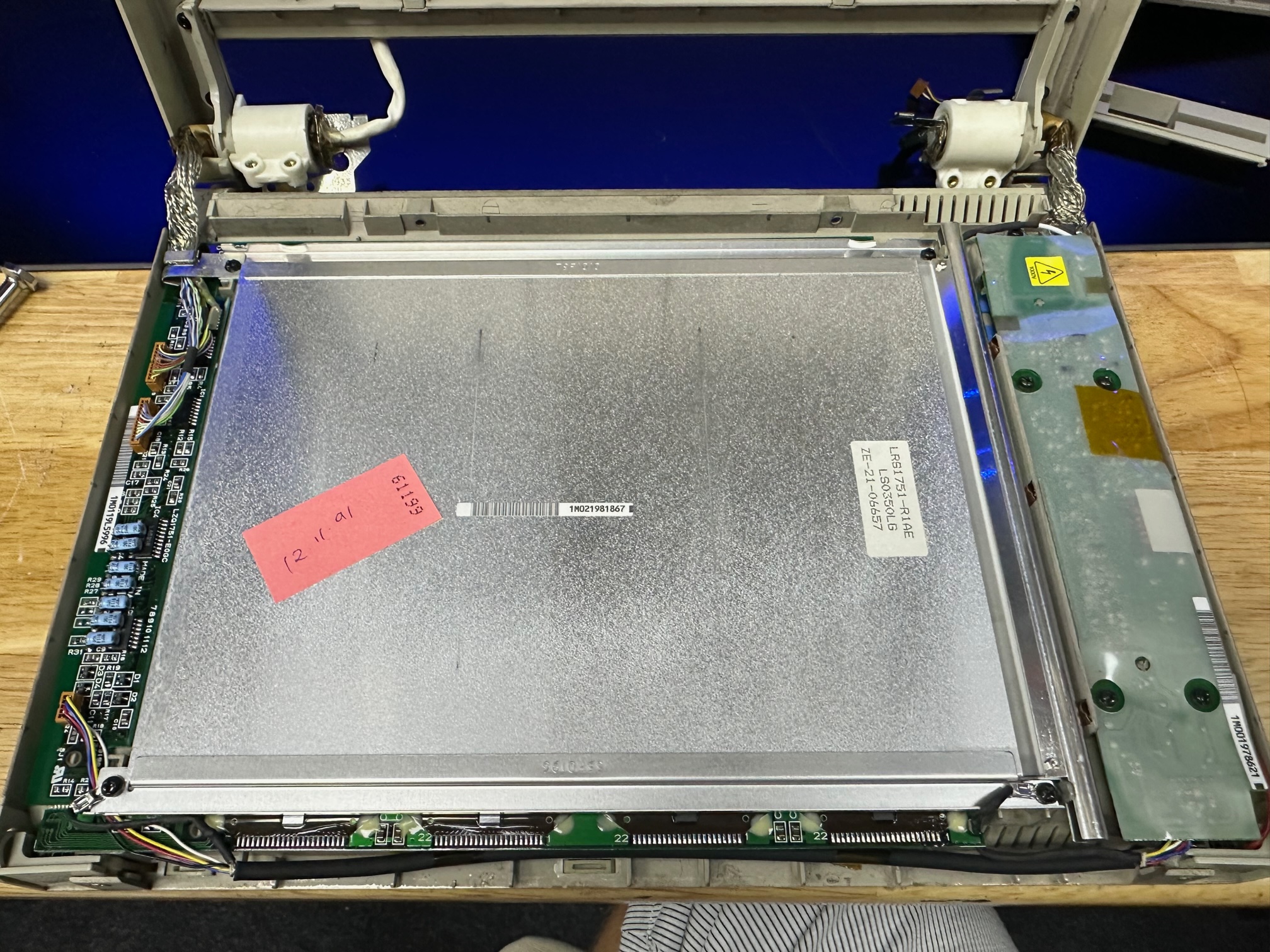
I help update the thinkpad TFT wiki to try and make it easier to source replacements when you need them for LCD screens. My focus tends to be on older machines, so it's not just TFTs in the main list now and whilst there are still voids in what it notes (seen where it groups together a bunch of different machines which do not, infact share the same screen), a lot of them are now correct.
Inside the LCD is the inverter, which comes out with 4 screws and is relatively easy except the 6 capacitors on it are very very shallow.
C1 - 33uf/25v
C2 - 33uf/25v
C5 - 33uf/10v
C11 - 33uf/10v
C13 - 10uf/35v
C14 - 10uf/25v
I didn't have small enough capacitors so I had to be creative and right-angle them with some electrical insulation around the legs. Note the close up of C1/C2 shows how absolutely rotten they were underneath (although on this journey, these and C5/C11 slightly, were the only caps I found to have leaked - I think as I have a slightly later-release motherboard, my mainboard caps were not of the same flawed design as some other L40SXs)
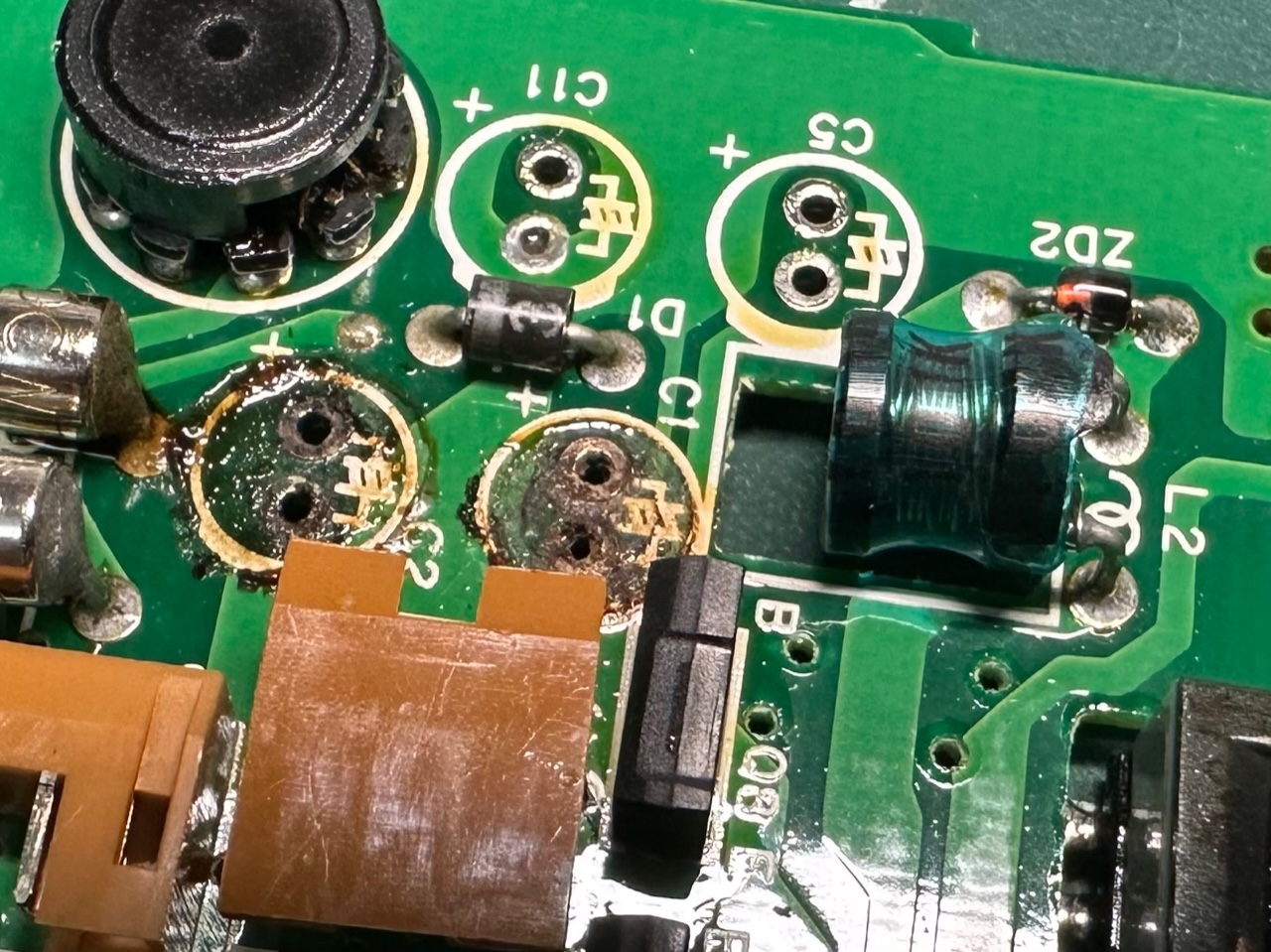
This is my inverter after replacing with less-than-ideal-but-perfectly-fulfil-the-job capacitors:
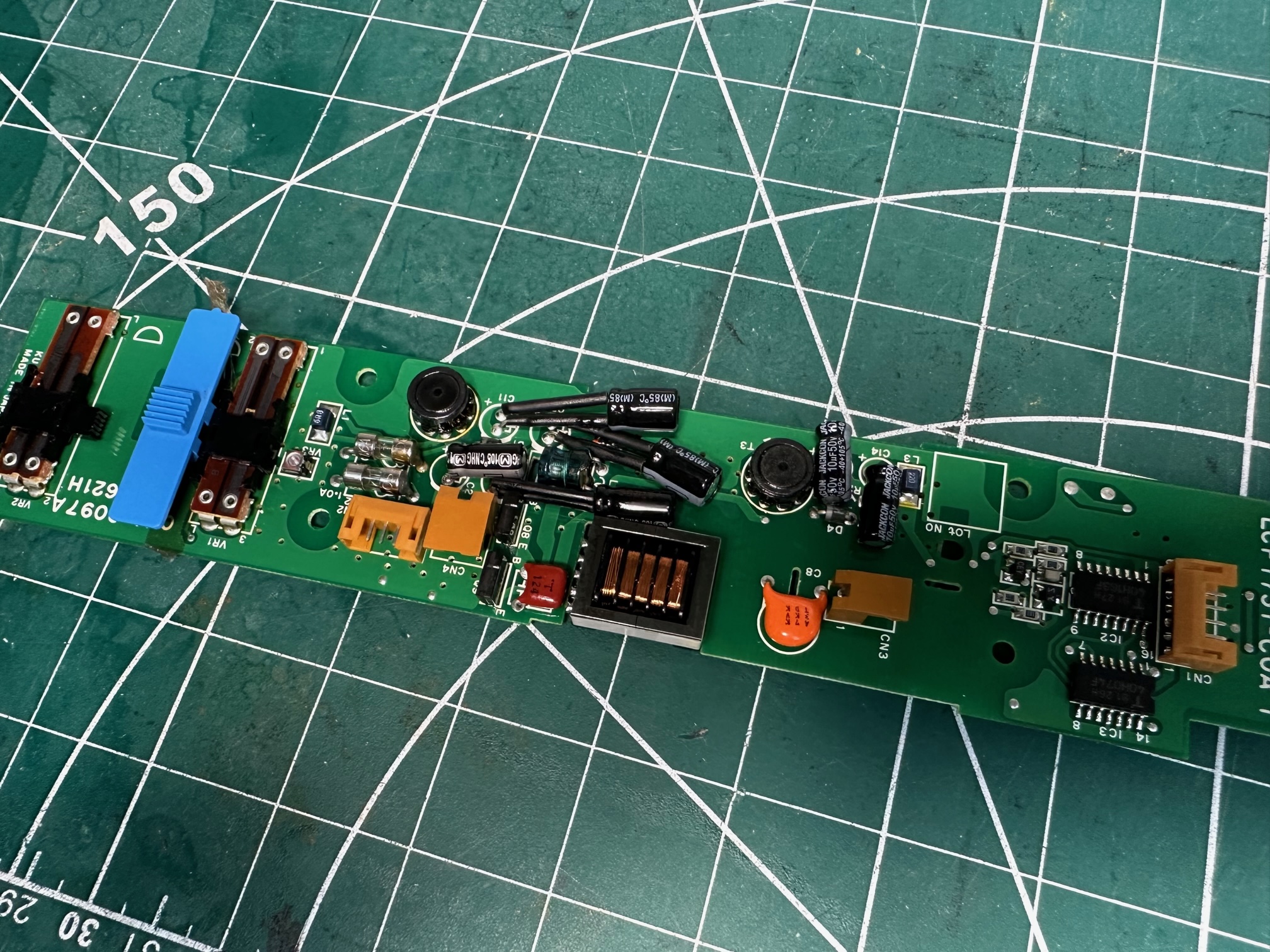
Finally there is the LCD itself which is the highest-risk change. I actually think all these caps were good and didn't show any signs of leaking, so if you're a gambler, I would maybe leave these 7 caps. They're actually fairly easy to remove but getting to them is a pain. You have to remove 4 screws holding the LCD down onto the lid and then you can unplug all the cables and then fold over the LCD 180 degrees sideways onto your bench, revealing the backs of the capacitors. There is a bit of plastic insulation stuck over the top which you would either peel off or cut a small piece off to get access to the bottom of the capacitors. I cut mine, below. They're simply 7 x 10u/35v through-hole capacitors. There is a fair bit of room above them so you can generally afford to go a little bigger if that's all you have. Mine were much bigger and the whole thing went back together with no problems.
Before, with the LCD unscrewed and turned upside down:
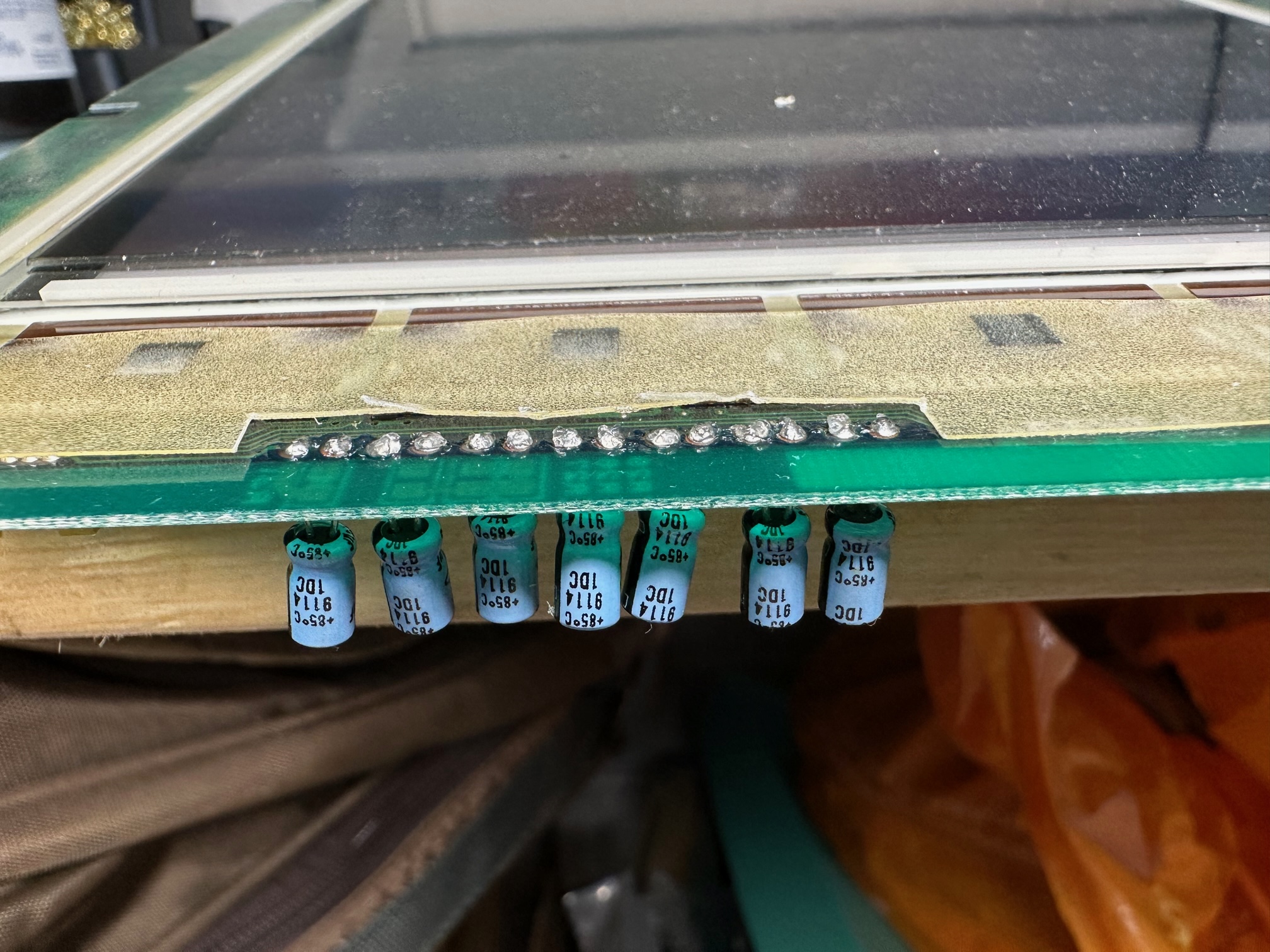
Here are my new, slightly bigger caps attached:

I was so relieved when I plugged the lid back in to test and there were no dead lines. I've found the thin wires which run all along the side of the LCD panel to the PCB can really easily get damaged and die/short. The key is to go gentle and try and get in and out quickly, once and with the least amount of movement possible.
Not-Capacitor Related..
A few people asked me about my L40 SX just to get a few more bits of info.
Drives - the floppy on this one is a standard 1.44Mb 3.5" IBM-compatible drive and works fine without any service so far. Which is very useful because the original IDE hard drive was dead. I have opened up some other L40SX machines which did not have any signs of having a hard drive, so I think some may have not come with them. I replaced my hard drive with a Compact Flash card and a 2.5" IDE->CF card, with MS-DOS 6.22 and Windows 3.11 - all installed from the original floppy disks. I did this a few years ago but I don't remember any issues. I simply booted using the MS-DOS installation disk 1 and F3'd out to do an FDISK on the CF card. This set it to a simple FAT16 parition and setup the MBR fresh for this machine/disk combo. After formatting, I simply installed MS-DOS 6.22 as usual and then followed up with Windows 3.11.
Numeric Keypad - I have acquired a few L40 SX machines over the years and a few of them came with this keypad. I don't know if it was originally included or was an optional extra, but it's very nice and I think fairly rare. It connects over some kind of unique RJ-45 cable (like the ones you get on ethernet cables).
Keyboard - Yes it feels nice. It's a bit soft for my liking and I think some people think it's some kind of weird Nirvana of a keyboard because Nostalgia Nerd on youtube did a video saying how amazing it is. It's fine.
Preservation - make sure you remove the main battery, even if it shows no signs of leakage. From distant memory there might also be a hibernation battery towards the back of the machine which also can leak and corrode everything around it with horrible fumes. Take both out and seal them up in an airtight bag if you want to keep them.
PSU - no doubt the external PSU 'brick' also has some high and low voltage capacitors in it, but I've got more important things to tackle than that.